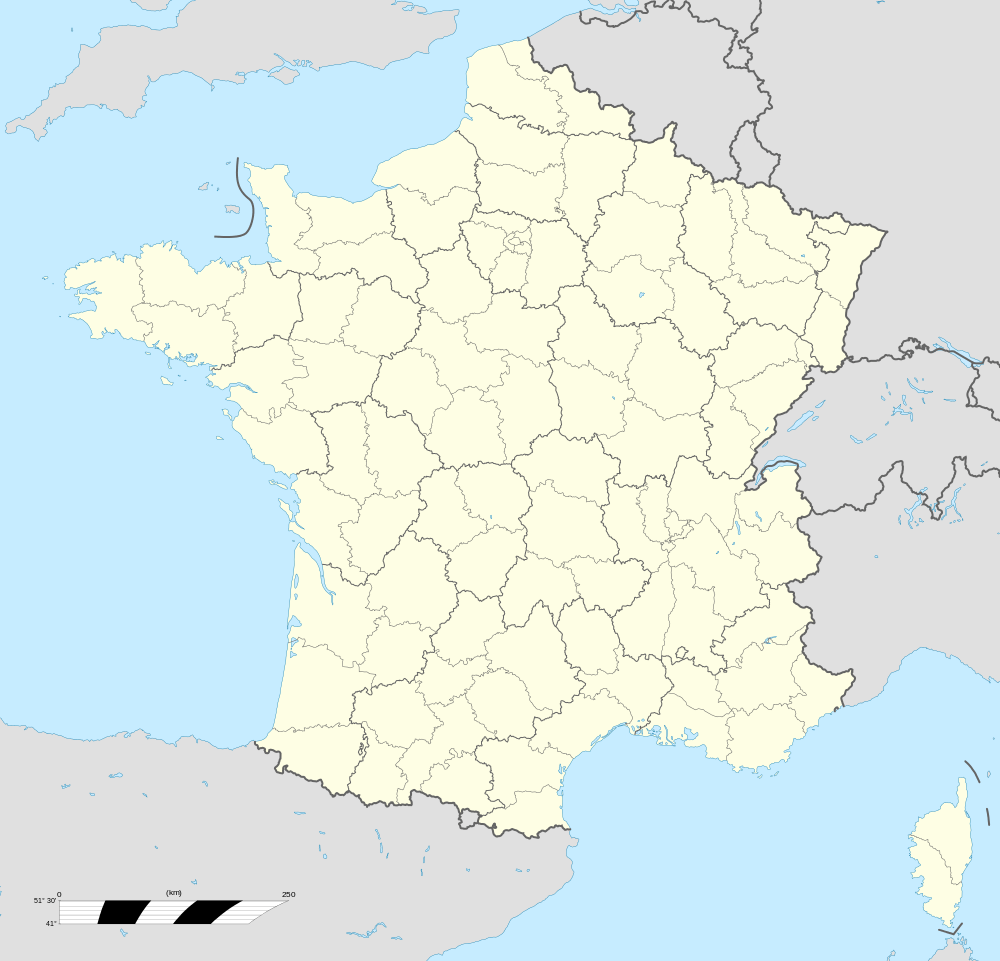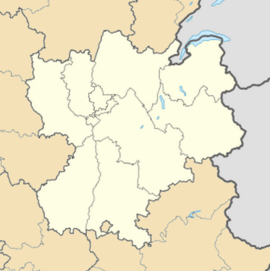Bourg-en-Bresse
| Bourg-en-Bresse | ||
|---|---|---|
|
Prefecture building of the Ain department | ||
| ||
 Bourg-en-Bresse | ||
|
Location within Rhône-Alpes region  Bourg-en-Bresse | ||
| Coordinates: 46°12′20″N 5°13′44″E / 46.2056°N 5.2289°ECoordinates: 46°12′20″N 5°13′44″E / 46.2056°N 5.2289°E | ||
| Country | France | |
| Region | Rhône-Alpes | |
| Department | Ain | |
| Arrondissement | Bourg-en-Bresse | |
| Intercommunality | Bourg-en-Bresse | |
| Government | ||
| • Mayor (2008–2014) | Jean-François Debat | |
| Area1 | 23.86 km2 (9.21 sq mi) | |
| Population (2008)2 | 40,203 | |
| • Density | 1,700/km2 (4,400/sq mi) | |
| INSEE/Postal code | 01053 / 01000 | |
| Elevation |
220–273 m (722–896 ft) (avg. 240 m or 790 ft) | |
|
1 French Land Register data, which excludes lakes, ponds, glaciers > 1 km² (0.386 sq mi or 247 acres) and river estuaries. 2 Population without double counting: residents of multiple communes (e.g., students and military personnel) only counted once. | ||
Bourg-en-Bresse (French pronunciation: [buʁkɑ̃bʁɛs]; Bôrg in Arpitan language) is a commune in eastern France, capital of the Ain department, and was capital of the former province of Bresse (Brêsse). It is located 70 km (43 mi) north-northeast of Lyon.
The inhabitants of Bourg-en-Bresse are known as Burgiens.
Geography
Bourg-en-Bresse is located at the western base of the Jura mountains, on the left bank of the Reyssouze, a tributary of the Saône. It lies 70 kilometers (43 mi) northeast of Lyon and at 50 kilometers (31 mi) of Lons-le-Saunier.
History
Roman remains have been discovered at Bourg, but little is known of its early history. Raised to the rank of a free town in 1250, it was at the beginning of the 15th century chosen by the dukes of Savoy as the chief city of the province of Bresse. In February 1535—1536 new style—it passed to France, during a full-scale French invasion of Savoy, but was restored to Duke Philibert Emmanuel in 1559, when he married Henri II's sister Marguerite. The Duke later built a strong citadel, which afterwards withstood a six-months' siege by the soldiers of Henry IV. The town was finally ceded to France in 1601. In 1814 the inhabitants, in spite of the defenseless condition of their town, offered resistance to the Austrians, who put the place to pillage.[1]
Population
| Historical population | ||
|---|---|---|
| Year | Pop. | ±% |
| 1793 | 6,533 | — |
| 1800 | 6,984 | +6.9% |
| 1806 | 7,417 | +6.2% |
| 1821 | 8,132 | +9.6% |
| 1831 | 8,996 | +10.6% |
| 1836 | 9,528 | +5.9% |
| 1841 | 10,219 | +7.3% |
| 1846 | 10,308 | +0.9% |
| 1851 | 12,068 | +17.1% |
| 1856 | 11,676 | −3.2% |
| 1861 | 14,052 | +20.3% |
| 1866 | 13,733 | −2.3% |
| 1872 | 14,280 | +4.0% |
| 1876 | 15,692 | +9.9% |
| 1881 | 18,233 | +16.2% |
| 1886 | 18,113 | −0.7% |
| 1891 | 18,968 | +4.7% |
| 1896 | 18,501 | −2.5% |
| 1901 | 18,887 | +2.1% |
| 1906 | 20,045 | +6.1% |
| 1911 | 20,545 | +2.5% |
| 1921 | 20,191 | −1.7% |
| 1926 | 20,364 | +0.9% |
| 1931 | 23,117 | +13.5% |
| 1936 | 24,746 | +7.0% |
| 1946 | 25,944 | +4.8% |
| 1954 | 26,699 | +2.9% |
| 1962 | 32,596 | +22.1% |
| 1968 | 37,887 | +16.2% |
| 1975 | 42,181 | +11.3% |
| 1982 | 41,098 | −2.6% |
| 1990 | 40,972 | −0.3% |
| 1999 | 40,666 | −0.7% |
| 2008 | 40,203 | −1.1% |
Sights
The chief of the older buildings is the church of Notre-Dame (Cathédrale Notre-Dame-de-l'Annonciation de Bourg-en-Bresse) (16th century), of which the façade belongs to the Renaissance; other parts of the church are Gothic. In the interior there are stalls of the 16th century. The other public buildings, including a handsome préfecture, are modern. The town hall (hôtel de ville) contains a library and the Lorin museum with a collection of pictures, while another museum has a collection of old costumes and ornaments characteristic of Bresse. Among the statues in the town there is one of Edgar Quinet (1803–1875), a native of Bourg.[1]

The church of Brou, a suburb of Bourg-en-Bresse, is of great artistic interest. Margaret of Bourbon, wife of Philip II of Savoy, had intended to found a monastery on the spot, but died before her intention could be carried into effect. The church was actually built early in the 16th century by her daughter-in-law Margaret of Austria, wife of Philibert le Beau of Savoy, in memory of her husband. The exterior, especially the façade, is richly ornamented, but the chief interest lies in the works of art in the interior, which date from 1532. The most important are the three mausoleums with the marble effigies of Marguerite of Bourbon, Philibert le Beau, and Margaret of Austria. All three are remarkable for perfection of sculpture and richness of ornamentation. The rood loft, the oak stalls, and the reredos in the chapel of the Virgin are masterpieces in a similar style.[1]
Economy
In the early 20th century, the manufactures consisted of iron goods, mineral waters, tallow, soap and earthenware, and there were flour mills and breweries; and there is considerable trade in grain, cattle and poultry – Poulet de Bresse.[1]
Transport
The Gare de Bourg-en-Bresse railway station offers connections to Paris, Strasbourg, Lyon and Geneva by high-speed rail, and several regional destinations. The A39 motorway connects Bourg with Dole and Dijon, the A40 with Mâcon and Geneva.
Miscellaneous
Bourg is the seat of a prefect and of a court of assizes, and has a tribunal of first instance, a tribunal and a chamber of commerce, and a branch of the Bank of France. Its educational establishments include lycées, and training collèges.
Bourg-en-Bresse was the finish of Stage 6 and the departure of Stage 7 in the 2007 Tour de France.
The Bourg Walk is a name of a bridge in Aylesbury, dedicated to the twin town. Former resident and past pupil of Aylesbury Grammar School, Alastair Harrison proposed the name to symbolically bridge the gap between the two towns, which has been received most favourably.
Personalities
Bourg-en-Bresse was the birthplace of:
- Claude Gaspard Bachet de Méziriac (1581–1638), mathematician
- Julien Benneteau, (born 1981), tennis player
- Georges Blanc, cook
- François Clerc (born 1983), football player for Olympique Lyonnais and the French national team
- Alain Giletti, (born on 9 November 1939), ice skater, 10 times French champion, 5 times European champion, 4 times vice-champion of Europe and 1 time World champion (1960)
- Jérôme Lalande (1732–1807), astronomer
- Daniel Morelon, cyclist
- Jean-Bernard Gauthier de Murnan (1748–1796), French officer for the Continental Army and a French General during the French Revolution
- Lionel Nallet, (born 14 September 1976), French international rugby union player (lock), currently playing for Castres Olympique in the Top 14
- Jacques Pépin (born 1935), noted French chef
- Edgar Quinet (1803–1875), historian and man of letters
International relations
Bourg-en-Bresse is twinned with:
 Brzeg, Poland
Brzeg, Poland Aylesbury, United Kingdom
Aylesbury, United Kingdom Bad Kreuznach, Germany
Bad Kreuznach, Germany Ankara, Turkey
Ankara, Turkey
Additionally, it has established partnerships with:
 San Severo, Italy
San Severo, Italy Parma, Italy
Parma, Italy.svg.png) Namur, Belgium
Namur, Belgium Córdoba, Spain
Córdoba, Spain
See also
- Bressan
- Arpitania
- Arpitan language
- Communes of the Ain department
- Pierre-Marie Poisson
References
- ↑ 1.0 1.1 1.2 1.3
 One or more of the preceding sentences incorporates text from a publication now in the public domain: Chisholm, Hugh, ed. (1911). "Bourg-en-Bresse". Encyclopædia Britannica 4 (11th ed.). Cambridge University Press. p. 330.
One or more of the preceding sentences incorporates text from a publication now in the public domain: Chisholm, Hugh, ed. (1911). "Bourg-en-Bresse". Encyclopædia Britannica 4 (11th ed.). Cambridge University Press. p. 330.
External links
| Wikimedia Commons has media related to Bourg-en-Bresse. |
- City council website (in French)
| ||||||
